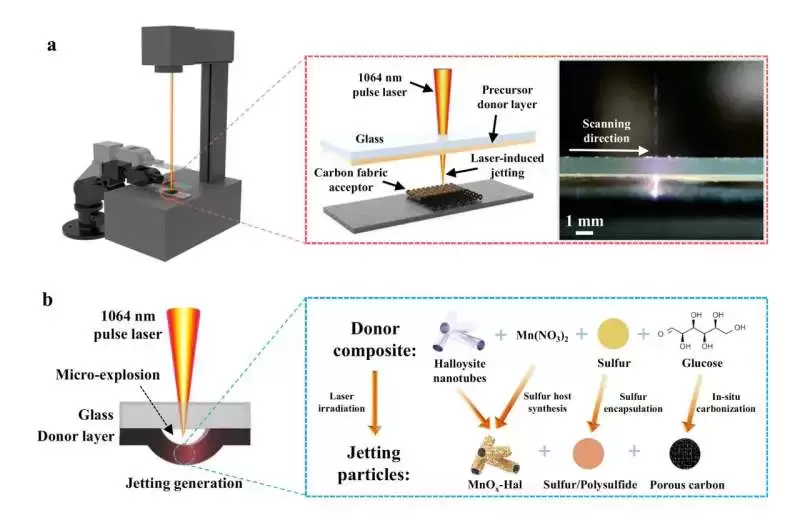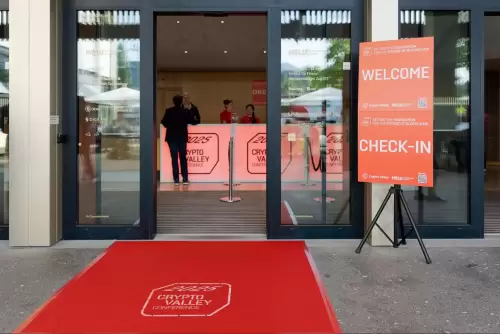 |
|
 |
|
 |
|
 |
|
 |
|
 |
|
 |
|
 |
|
 |
|
 |
|
 |
|
 |
|
 |
|
 |
|
 |
|
一个研究团队开发了一种创新的单步激光打印技术,以加速锂硫电池的制造。

A research team has developed a single-step laser printing technique for the rapid manufacturing of lithium-sulfur batteries. This technique integrates the commonly time-consuming active materials synthesis and cathode preparation in a nanosecond-scale laser-induced conversion process, and is set to future industrial production of printable electrochemical energy storage devices.
一个研究团队开发了一种单步激光打印技术,用于快速生产锂硫电池。该技术将通常耗时的活性材料合成和阴极制备整合到纳秒尺度激光诱导的转换过程中,并将其设置为未来的可打印电化学能源存储设备的工业生产。
The team was led by Prof. Mitch Li Guijun, Assistant Professor from the Division of Integrative Systems and Design at the Hong Kong University of Science and Technology (HKUST). The findings are published in the journal Nature Communications.
该团队由香港科学技术大学(HKUST)综合系统与设计部助理教授Mitch Li Guijun教授领导。这些发现发表在《自然通讯》杂志上。
Lithium-sulfur batteries are promising candidates to supersede existing lithium-ion batteries due to sulfur cathodes’ high theoretical energy density. To ensure the rapid conversion of sulfur species, these cathodes are typically composed of active materials, host materials (or catalysts), and conductive materials.
锂硫电池是由于硫磺阴极高理论能量密度而有望取代现有的锂离子电池。为了确保硫种的快速转化,这些阴极通常由活性材料,宿主材料(或催化剂)和导电材料组成。
However, the fabrication of host materials and preparation of sulfur cathodes often involve complicated, multistep, and labor-intensive processes that require varying temperatures and conditions, which poses challenges for efficient and low-cost industrial production.
但是,宿主材料的制造和硫磺阴极的制备通常涉及需要不同温度和条件的复杂,多步骤和劳动密集型过程,这给有效和低成本的工业生产带来了挑战。
To overcome these challenges, Prof. Li’s team developed a single-step laser printing technique for the rapid manufacturing of integrated sulfur cathodes.
为了克服这些挑战,李教授的团队开发了一种单步激光打印技术,用于快速制造综合硫硫磺的阴极。
During this high-throughput laser-pulse irradiation process, the precursor donor is activated, performing jetting particles that include in-situ synthesized halloysite-based hybrid nanotubes (host material), sulfur species (active material), and glucose-derived porous carbon (conductive component). The mixture is printed onto a carbon fabric acceptor, forming an integrated sulfur cathode. Notably, the laser-printed sulfur cathodes demonstrate outstanding performance in both coin and pouch lithium-sulfur cells.
在这个高通量激光渗水辐照过程中,前体供体被激活,进行喷气颗粒,其中包括基于原位的基于Halloysite的基于Halloysite的杂化杂种纳米管(宿主材料),硫(活性材料)和葡萄糖衍生的多孔碳(导电组件)。将混合物印在碳织物受体上,形成综合的硫阴极。值得注意的是,激光打印的硫阴道在硬币和小袋锂硫细胞中均表现出出色的性能。
Prof. Li. said:
李教授。说:
“Traditional manufacturing processes of a cathode/anode in ion battery usually contain the synthesis of active materials (sometimes combined with host material/ catalyst), the preparation of mixture slurry, and the assembly of cathode/anode,
“离子电池中阴极/阳极的传统制造过程通常包含活性材料的合成(有时与宿主材料/催化剂结合),混合物浆料的制备以及阴极/阳极的组装,
“These steps are usually carried out separately under different temperatures and conditions because the materials behave differently. As a result, the whole process can take tens of hours or even several days.”
“这些步骤通常在不同的温度和条件下分别进行,因为材料的行为不同。因此,整个过程可能需要数十小时甚至几天。”
Prof. Li said,
李教授说,
“Our newly developed laser-induced conversion technology offers a way to combine these processes into a single step at nanosecond speeds.
“我们新开发的激光诱导的转换技术提供了一种将这些过程以纳秒速度相结合到一个步骤中的方法。
“The printing speed can achieve about 2 cm2/minute using only a single beam laser. A 75 × 45 mm2 sulfur cathode can be printed within 20 minutes and supply power for a small screen for several hours when assembled into a lithium-sulfur pouch cell.”
“打印速度只能使用单个梁激光器才能达到约2 cm2/分钟。75×45 mm2硫的阴极可以在20分钟内打印出75×45 mm2的硫磺阴极,并在组装成小屏幕时为小屏幕提供数小时的电源。”
Dr. Yang Rongliang, the first author of this work and former postdoctoral fellow at HKUST, added,
这项工作的第一作者Yang Rongliang博士,Hkust的前博士后研究员,他补充说,
“These intriguing findings generated from our study on laser-material interaction.
“这些有趣的发现是我们关于激光材料相互作用的研究产生的。
“The laser-induced conversion process can be characterized as an ultra-concentrated thermal phenomenon. The irradiated materials undergo a complex transient heating and cooling process, with theoretical transient temperatures reaching up to thousands of degrees Kelvin.”
“激光诱导的转化过程可以表征为超浓缩的热现象。辐照的材料经历了复杂的瞬时加热和冷却过程,理论上的瞬态温度达到了数千度开尔文。”
The precursor materials decompose, and the decomposed particles recombine to form new materials.
前体材料分解,分解的颗粒重新组合以形成新材料。
“This ultra-concentrated thermal process not only enables the formation and combination of materials with different natures, but also drives the concomitant micro-explosions that facilitate the jetting and transferring of forming particles.”
“这种超浓缩的热过程不仅可以使材料具有不同的本质的形成和组合,而且还驱动了促进形成颗粒的喷射和转移的伴随微探索。”
免责声明:info@kdj.com
所提供的信息并非交易建议。根据本文提供的信息进行的任何投资,kdj.com不承担任何责任。加密货币具有高波动性,强烈建议您深入研究后,谨慎投资!
如您认为本网站上使用的内容侵犯了您的版权,请立即联系我们(info@kdj.com),我们将及时删除。
-

-

- 模因硬币Neo Pepe(NEOP)承诺将标杆设置为更高
- 2025-06-14 12:00:26
- 加密货币世界对创新和炒作并不陌生,但是时不时地出现了一个项目,使标准更高。您是Uniswap的粉丝吗?
-

- 2025年领先的加密预售不仅仅是炒作,它们提供了真正的实用性
- 2025-06-14 11:55:12
- 本文不代表投资建议。此页面上的内容和材料仅用于教育目的。
-

-

-

-

- 随着所有前100个硬币的创纪录价格上涨,加密市值下跌1%至$ 3.58T
- 2025-06-14 11:45:12
- 加密货币市场如今又增加了,几乎所有前100个硬币在过去24小时内都呈上涨。
-

- BYBIT快速跟踪付款和支出奖励,并通过统一的BYBIT PAY和BYBIT卡的统一计划
- 2025-06-14 11:45:12
- 拜比特(Bybit)是全球第二大加密货币交易所通过交易量的交换
-































































